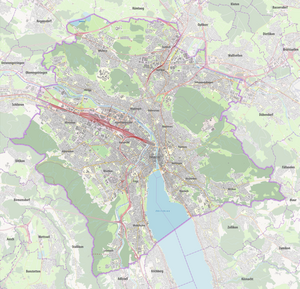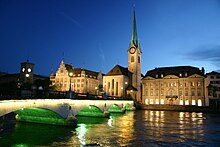Munster Bridge (Zurich)
Coordinates: 47 ° 22 ′ 11 " N , 8 ° 32 ′ 35" E ; CH1903: six hundred and eighty-three thousand four hundred thirteen / 247114
| Münsterbrücke Helmhausbrücke |
||
|---|---|---|
| Münsterbrücke, view towards Lake Zurich | ||
| Official name | Munster Bridge | |
| use | Connection between Fraumünster and Grossmünster | |
| Crossing of | Limmat | |
| place | Old town (District 1), Zurich | |
| construction | Arch bridge | |
| construction time | 1836–1838 current structure | |
| Civil engineer | Alois Negrelli | |
| location | ||
|
|
||
| Bridges in the city of Zurich | ||
The Münsterbrücke , also popularly known as the Helmhausbrücke , spans the Limmat in Zurich between the Stadthausquai and Limmatquai . The road bridge connects the eponymous churches of Fraumünster and Grossmünster . The arch bridge , built with natural stones , is known as the most beautiful Limmat bridge in Zurich and is the oldest Limmat crossing in the city that has been preserved in its original state.
history

The Zurich Commercial Association commissioned the construction of the bridge. The structure was erected in place of a wooden footbridge, known as the upper bridge, between 1836 and 1838 by the Zurich builders Conrad Stadler and Johann Jakob Locher-Oeri and the master stonemason Heinrich Staub according to plans by Alois Negrelli . After the Rathausbrücke it was the second navigable bridge over the Limmat in Zurich .
The Münsterbrücke has two lanes and sidewalks on both sides. A tram line initially used it until May 1901 and later again from 1910 to 1924. At the end of the 1990s, extensive repairs followed for around six million euros. An equestrian statue of Hans Waldmann , the work of the sculptor Hermann Haller , has stood on the western bridgehead since April 6, 1937 . The bridge has been illuminated as one of the three pilot projects since 2004 for the Lumière plan .
construction
The structure consists of four flat bridge arches with a clear width of 49 feet (14.7 meters) and an arrow height of 7 feet (2.1 meters) above the Limmat, as well as a fifth arch over an access canal to the former granary opposite the Fraumünster. Between the four 33 foot (9.9 meter) wide arches are three pillars 8 feet (2.4 meters) thick. Black marble (Jurassic limestone) from quarries on Lake Walen was used for the vaults and cladding, which are a maximum of 25 lines (75 centimeters) thick at the apex , while the cornices and pillars are made of Gotthard granite from Mellingen AG . The cast iron railing comes from the Grand Duchy of Baden . The pillars and abutments are based on 472 oak piles with lengths of up to 52 feet (15.6 meters). The foundations were made behind curbs or with caissons .
Web links
- Adi Kälin: Why Zurich celebrated a new bridge with so much pomp. In: Neue Zürcher Zeitung , August 19, 2018.
Individual evidence
- ↑ a b Richard Heierli, Fritz Hirt, Heinrich Hofacker, Willi Hofmann, Urs Schneider, Erich Möschler: Quaibrücke Zurich. In: Swiss engineer and architect, 10/1985, p. 183
- ↑ Adi Kälin: Why Zurich celebrated a new bridge with so much pomp In: Neue Zürcher Zeitung of August 18, 2018
- ^ Lumière Münsterbrücke
- ^ Negrelli: The new cathedral bridge over the Limmat in Zurich. In: Journal about the entire construction industry , Vol. 3 (1839), Issue 6, pp.190–191 (PDF, 14.6 MB)




